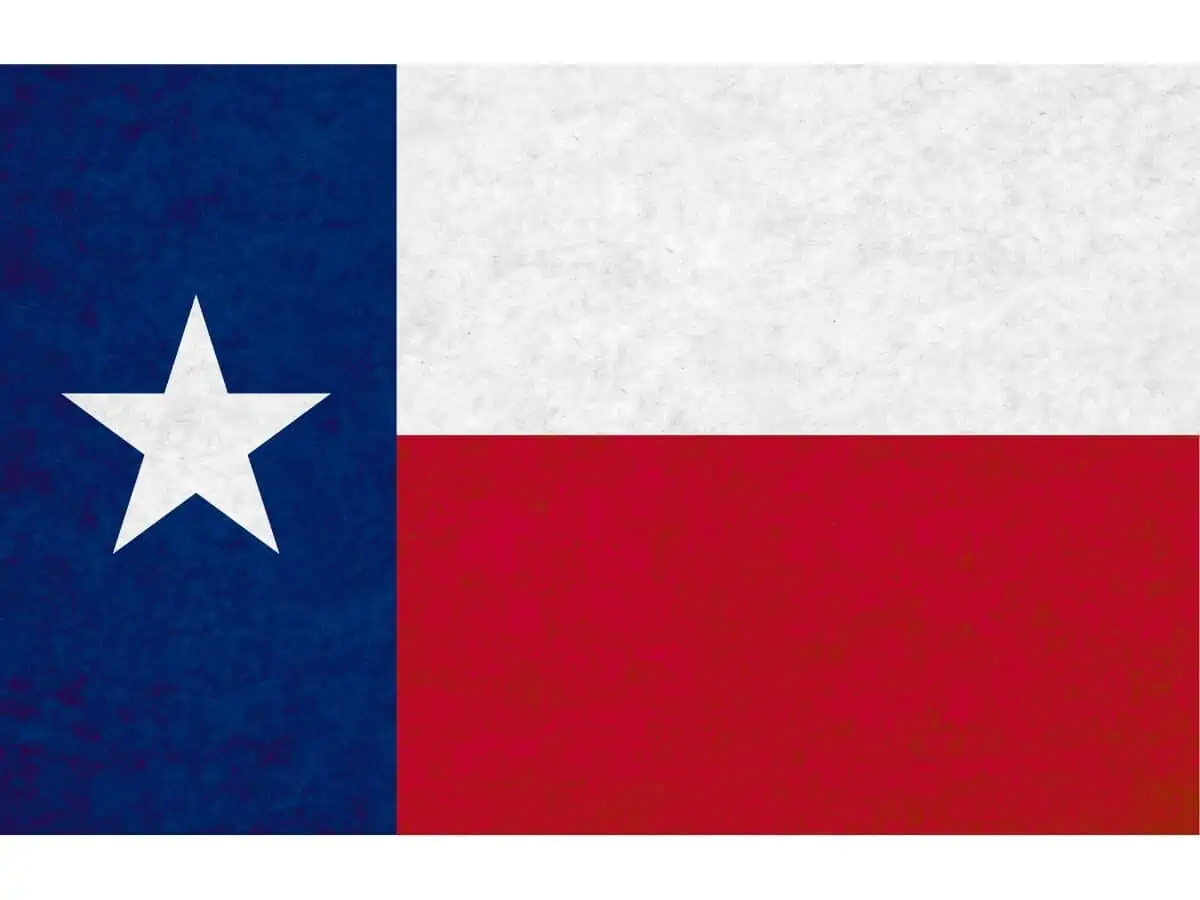There are a lot of fascinating things about Texas, this includes the state’s flag and the history associated with it.
The Texas flag that we’re familiar with today wasn’t always the one the state used. Texas has had six different flags flown over it since 1519. These flags are those of Spain, France, Mexico, the Republic of Texas, the Texas Confederacy, and the US flag.

What Does the Texas Flag Look Like?
The Texas flag has the same colors and design as the United States flag. It has a vertical blue stripe down the flag’s length on the hoist. That stripe is emblazoned with a single large, white star, hence Texas being nicknamed The Lone Star State.
On the flag’s fly end, you’ll find a pair of horizontal stripes equal in size. The upper stripe is white, while the lower one is red.
Symbolism in the Texas Flag
The colors of the Texas flag weren’t chosen haphazardly. Each of them has a symbolic significance attached to it. The red stripe included in the flag is a symbol of bravery. On the other hand, the blue and white portions of the flag stand for loyalty and purity, respectively.
Generally speaking, the whole flag is a totem of independence. This is highlighted by the lone star on the flag, representing Texas becoming an independent state after being under Spanish, Mexican, and French rule for so long.
Are the Texas Flag and Chile Flag the Same?
If you put the Texas flag and the Chilean flag side by side, you may get the impression that they’re identical. However, this is not true.
This isn’t to say there aren’t significant similarities between the two flags. The inception of both flags resulted in Texas and Chile gaining their independence from Spain and Mexico.
The Chilean flag is also sometimes referred to as Le Estrella Solitaria, which, when translated to English, means The Lone Star. The difference between the two flags’ designs is quite subtle. The Chilean flag has the same colors and design as the Texas flag.
The distinction is that the vertical blue stripe on the Chilean flag doesn’t go all the way down its length as it does on its Texan counterpart.

History of the Texas Flag
The history of Texas as a state involves centuries of colonial rule. Before The Lone Star state became independent, it was under the control of Spain, Mexico, and France at different points in its history.
Between 1519 and 1685
Between 1519 and 1685, Texas was a Spanish colony. In turn, the state’s official flag was the familiar red and yellow-striped flag of Spain that we know today. For the next six years, Texas was ruled by the Kingdom of France and flew its blue and gold fleurs-de-lys flag.
From 1690 to 1836
Then, Texas became a Spanish colony from 1690 to 1821 and returned to the Spanish flag. Between 1821 and 1836, Texas was under Mexican rule, and its official flag was the vertically striped green, white, and red one.
After 1836
The year 1836 marked the declaration of Texas’ independence from colonial rule. It was at this time that Texas became an independent republic. It was time for Texas to come up with its flag. The Republic of Texas’ congress decided to go for a dark blue flag centrally emblazoned with a lone yellow star.
However, that design didn’t last very long. Only three years later, the republic of Texas decided to change its flag to the one we know today.
This flag transformed from being the national flag of Texas to being the state flag when Texas became part of the United States in 1845. Interestingly enough, the Texas flag is the only state flag that used to be the flag of a sovereign nation.
Correct Way to Handle Texas Flag
Texans take great pride in their state and its history and culture. This is why there are very specific guidelines for how you should handle the state’s flag.
These guidelines were written into law in 1933.
Similarly to the United States flag, the Texas flag should never be made to touch the ground. Additionally, it should only be flown during nighttime if there’s sufficient lighting for it to be visible. Finally, if a Texan flag is damaged it should be disposed of by burning.
Guidelines For Displaying Texas Flag
When flaunting your Texan pride by putting the state flag on full display, here’s the right way to do so:
- If you display the flag vertically, ensure the blue stripe is on top. Additionally, have the white stripe on the right (the viewer’s left).
- In the case of a horizontal display, ensure that the white stripe is the uppermost one and that the blue stripe is on the right (the viewer’s left).
- Never fly the flag upside down unless you’re trying to communicate that you’re in distress.
- If you’re going to display the Texas flag and the US flag side by side, make sure to have the US flag on the right (the viewer’s left).
How to Fold Texas Flag the Right Way
Here’s how to fold the Texas flag correctly:
- Fold the flag along its horizontal axis so the red stripe is visible.
- Fold the flag along the same axis again, so the red stripe is hidden inside the fold.
- Now the star should be facing downwards. Fold one of the white stripe’s corners to form the edge of a triangle and then keep folding in the same manner along the whole flag.
Can You Fly The Texas Flag Higher Than the US Flag?
There’s a common misconception that the Texas flag is the only one amongst all state flags that can be flown at a greater height than the national flag. The Texas flag should be flown at the same height as the US flag, just like any other state flag.
Ideally, any state flag should be flown at a lower height than the United States flag and not outshine it in any way.
Interesting Facts About the Texas Flag
Here are some interesting pieces of trivia about the Texas state flag:
- Do you know how they say everything’s bigger in Texas? In line with that sentiment, the University of Texas at Austin is home to the world’s most enormous Texas flag. It’s 100 feet by 150 feet and weighs a whopping 450 pounds!
- If you book a tour of the Texas State Capitol, the flag you’ll see in there is a replica. The original is only brought out when the house of representatives is in session.
Texas Flag FAQs
Here are some common questions surrounding the Texas flag (and their answers).
1. What was Texas’ original flag?
The Texas flag we know today isn’t the state’s original flag. After Texas gained its independence from Mexico in 1836, the newly formed republic shed the Mexican flag and designed its flag consisting of a single yellow star positioned centrally on a field of dark blue.
This flag was known as the “Burnet flag” about the former president of the Texas republic. It was David G. Burnet who came up with the design.
2. What does an upside-down Texas flag mean?
As with all flags, flying the Texas flag upside down indicates distress or mortal danger. This is why it’s incredibly important to avoid flying the flag upside down when there’s no impending threat to avoid causing any unnecessary panic.
Contrary to popular belief, flying the flag upside down isn’t considered disrespectful or unpatriotic.
3. How many flags has Texas been under?
Since 1519, Texas has had many flags associated with it, six. These six flags include the Spanish, French, and Mexican flags. Texas has also been under the Republic of Texas flag, the Texas Confederacy flag, and the United States flag.
It wasn’t until 1839 that the Texas flag we see today came into existence.
4. Why is Texas the Lone Star State
The nickname of the second-largest state in the United States is a direct reference to its flag. The flag features a single, large star positioned on the blue-striped portion of it.
This star symbolizes the state’s struggle for independence throughout its history, which finally came to fruition in 1836. It’s a testament to Texas’ perseverance and do-it-yourself attitude.
References
Appearance of Texas flag: britannica.com
Height to fly Texas flag at: abc13.com
The Burnet flag: house.texas.gov
Christian Linden is a seasoned writer and contributor at Texas View, specializing in topics that resonate with the Texan community. With over a decade of experience in journalism, Christian brings a wealth of knowledge in local politics, culture, and lifestyle. He holds a Bachelor's degree in Communications from the University of Texas. When he's not writing, Christian enjoys spending weekends traveling across Texas with his family, exploring everything from bustling cities to serene landscapes.











